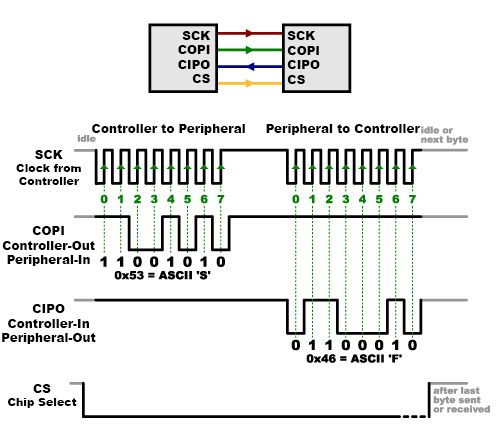- Serial Program Ing (spi) Enable Command
- Serial Program Ing (spi) Enabled
- Spi Bus Specification Pdf
- Serial Program Ing (spi) Enabler
Introduction Serial Peripheral Interface (SPI) is an interface bus commonly used to send data between microcontrollers and small peripherals such as shift registers, sensors, and SD cards. It uses separate clock and data lines, along with a select line to choose the device you wish to talk to. TMS320C672x DSP Serial Peripheral Interface (SPI) This reference guide describes the TMS320C672x Serial Peripheral Interface Module (SPI). The SPI is a synchronous, full-duplexserial port which supports 3-pin,4-pin,and 5-pinoptions. Figure 1 contains a block diagram of the SPI module. The major SPI components are:.16-bitshift register (SPIDAT0).
MEAM.Design - ATmega32 Programming - Serial Peripheral Interface (SPI)
Overview
The ATmega32U4 has a number of serial communications modules, including one that conforms to the SPI standard. This port has full-duplex communication over three wires, can be used as either a master or a slave, has a configurable bit rate, and received packets can generate interrupts.
Configuration
To configure the SPI module, you need to disable power reduction, configure a few I/O pins, set a clock prescaler, select the SPI mode, (optionally) enable interrupts, and finally enable the SPI subsystem. It is also possible to modify many of the details of SPI operation, including the order in which bytes will be shifted between the devices, the clock polarity, and the clock phase - see the full datasheet for more information. Once enabled, the steps that you will take will depend upon whether you are configuring the device as a master or a slave. Herein we are going to assume that the ATmega32U4 is operating as the master device.
1. Disable Power Reduction
If the device has been put into a low-power mode, you must bring it back to full power to allow use of the SPI module. This is done by setting the PRSPI bit in PRR0 register.

2. Configure I/O Pins
The SPI lines consist of SCLK (Serial CLock), MOSI (Master-Out, Slave-In), MISO (Master-In, Slave-Out), and the optional SS (Slave Select). These lines are multiplexed onto the lower half of Port B. To configure as the master device, the data direction registers should be set as:
| SPI function | Port pin | direction |
| MISO | B3 | input |
| MOSI | B2 | output |
| SCLK | B1 | output |
| SS | B0 | output (input for slave) |
3. Set the clock prescaler
The SPI clock is prescaled by the SPR1 and SPR0 bits in SPCR register, where
| SPCR: SPR1 | SPCR: SPR0 | |
| 0 | 0 | /4 |
| 0 | 1 | /16 |
| 1 | 0 | /64 |
| 1 | 1 | /128 |
4. Select either master or slave mode
Serial Program Ing (spi) Enable Command
To place the SPI module into Master mode, the MSTR bit in the SPCR register should be set to 1.
(Note - If SS is configured as an input and is driven low while MSTR is set, MSTR will be cleared, and SPIF in SPSR will become set. The user will then have to set MSTR to re-enable SPI Master mode.)

5. (Optionally) Enable interrupts
To enable interrupts from the SPI module, set the SPIE bit in the SPCR register to 1, and be sure to enable global interrupts, as explained here. Interrupts will point to SPI_STC_vect when a serial transfer is complete.
6. Enable the module
To enable SPI, set the SPE bit in the SPCR register to 1.
Usage
The SPI system operates by shifting data between two registers, one on the master and one on the slave.
Serial Program Ing (spi) Enabled
1. To begin a new serial transfer, you must first pull the SS line low using clear(PORTB,0);
2. With SS low, write 8-bits of data into the SPDR register. The SPI module will recognize that you've written new data, and it will shift the packet over the slave, while simultaneously shifting in a packet from the slave.
3. Once the 8-bit transfer is complete, the SPIF bit in SPSR will go high (and if enabled, the SPI interrupt will be generated). The SPIF interrupt flag can be cleared be either executing the ISR or by first reading the SPIF bit then by either reading from or writing to SPDR.
4. If you are interested in the data returned from the slave, you can read it rom the SPDR register.
Spi Bus Specification Pdf
5. To transfer additional bytes, repeat steps 2-4.
Serial Program Ing (spi) Enabler
6. To end transmission, return the SS line high using set(PORTB,0);

Sample Code
This sample code should enable the SPI module, transfer 0xAA to the slave, and read whatever is returned by the slave.

char outgoing = 0xAA;char incoming;//disable power reduction to allow SPI:clear(PRR0,PRSPI);// MOSI, SCLK, and SS as output:DDRB |= (1<<DDRB2) | (1<<DDRB1) | (1<<DDRB0);// Enable SPI, Master mode, prescaler = /128:SPCR = (1<<SPE) | (1<<MSTR) | (1<<SPR1) | (1<<SPR0);// send SS low to begin transmissionclear(PORTB,0);// send a byte to the slaveSPDR = outgoing;// wait for transmission to finishwhile(!check(SPSR,SPIF));// read the byte returned from the slaveincoming = SPDR;// send SS high to end transmissionset(PORTB,0);